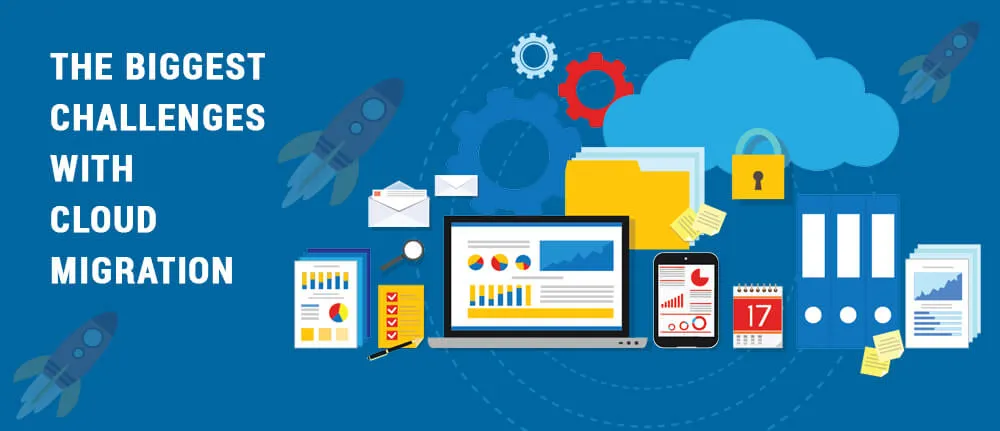How to Do Forecasting in Power BI (Steps & Accuracy Metrics)
Remember our last guide - Power BI forecasting? It revealed things that truly blocks accuracy, both structural and situational. Now it's time to take the next step. Knowing Power...
Listening is fun too.
Straighten your back and cherish with coffee - PLAY !

The most demanding and dynamic technologies are cloud technology. Today, almost every business deals with cloud computing setup by the assistance of Cloud-based solution providers and Software Development firms. It has changed the traditional business models and has introduced concepts such as Online collaboration and AI as a service. Most of the companies are considering cloud migration. It is simple, flexible, scalable, reliable, cost-effective, improved performance and disaster recovery and faster development.
But every technology has some hurdles which should be taken care of by the companies and organizations before making any step.
The challenges of cloud migration are as follows:
Missing a clear strategy that determines the business objective.
Cloud Sprawl caused when there is no clear understanding of the full scope of the cloud environment.
Crossing the planned budget.
Security breach
Human understanding and zero skills to operate the new infrastructure.
All these challenges have the right solutions to resolve them. Let's discuss how we can overcome the challenges in cloud migration and make the transition smooth.
The most common mistake every company or organization commits is not having any clear business objectives or any liable migration plan. Sometimes the manager finds themselves stuck at something after performing a fair amount of work for migration. Due to that, clearing the formulation of business goals and reconstructing the migration strategy from scratch works.
The better strategy ensures a smooth transition avoid analysis breakdown in the later stage of the process. It is very important to choose within the wide variety of choices whether to choose public, private or hybrid cloud infrastructure like Infrastructure as Service (IaaS), Platform as service (PaaS) and Software as Service (SaaS) models.
Proper planning of every stage of the migration directs you to make the right choices and achieve your target by overcoming unnecessary spending.
Cloud Sprawl is the another most common issue with the migration. It means that your company or organization doesn't owe the complete centralized visibility and control all of your cloud infrastructure components. When your company is facing issues with more than one cloud instance, services or providers, it's hard to get full access to your resources which are in use.
Several preventive steps may help to avoid this situation and implement unified management solutions to all cloud services.
Exceeding your budget for cloud migration often goes hand in hand with cloud sprawling. To have an eye on your spending in check and to measure these costs since day one and assign these things to a coordinate from your organization. Calculating your costs and performance on an ongoing basis is essential for evaluating the ROI of your cloud migration to acknowledge that your migration was successful.
Every cloud migration process has an issue of security breaching which is supposed to be addressed. To avoid such security weak points during the move, but make sure that there is one DevOps engineer in-house with expertise in cloud security or have a word with the cloud provider.
Some measures such as setting security configuration parameters, automating security processes and building monitory systems should be embedded in DevOps operations.
Two important concerns are 1) Availability at the component level and 2) Architecture level to secure either one specific component or entire environment at the time of failure.
-The core issue with Cloud migration is due to the dearth of training in the employees. One should be aware of organizing the IT functions in the cloud as it is different from the same processes which run in-house like DevOps. Better understanding, skills, and knowledge to operate the new infrastructure. The best cloud providers even offer training sessions to bring the leader and team on the same page. Training and certification should be included in your migration timeline.
To sum up, moving cloud is just not a challenge but an opportunity to make the current business process agile and innovative. Firstly, gather all infrastructure components, business processes and build the strategy to make your cloud migration successful.

Remember our last guide - Power BI forecasting? It revealed things that truly blocks accuracy, both structural and situational. Now it's time to take the next step. Knowing Power...

Did you know that 70% of CTOs (Chief Technology Officers) hesitate to adopt Microsoft Power BI because of its myths and misconceptions that float around. What they fail to see is...

Every CTO knows the struggle of managing complex reports. The inefficiency of scattered data, the constant juggling between reporting tools, the challenge of ensuring accurate KPIs...